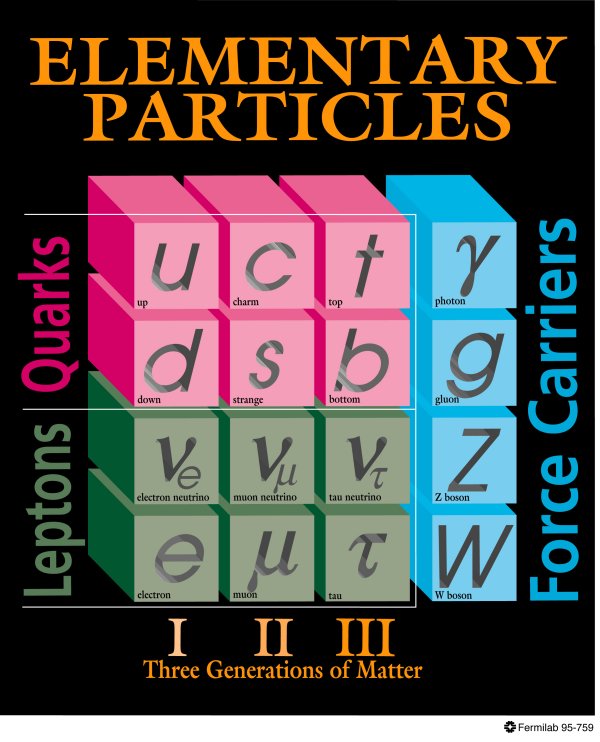Inquiring Minds
|
The science of matter, space and time main page | what is the world made of? | how to find the smallest particles what to expect in the future | why support science | Standard Model discoveries |
||||
|
||||
|
Physicists have identified 12 building blocks that are the fundamental constituents of matter. Our everyday world is made of just three of these building blocks: the up quark, the down quark and the electron. This set of particles is all that's needed to make protons and neutrons and to form atoms and molecules. The electron neutrino, observed in the decay of other particles, completes the first set of four building blocks.
For some reason nature has elected to replicate this first generation of quarks and leptons to produce a total of six quarks and six leptons, with increasing mass. Like all quarks, the sixth quark, named top, is much smaller than a proton (in fact, no one knows how small quarks are), but the top is as heavy as a gold atom! Although there are reasons to believe that there are no more sets of quarks and leptons, theorists speculate that there may be other types of building blocks, which may partly account for the dark matter implied by astrophysical observations. This poorly understood matter exerts gravitational forces and manipulates galaxies. It will take earth-based accelerator experiments to identify its fabric. The building blocks of nature (video, 6 min.) The forces Scientists distinguish four elementary types of forces acting among particles: strong, weak, electromagnetic and gravitational force.
Each force has its own characteristic bosons:
Physicists expect that the gravitational force may also be associated with a boson particle. Named the graviton, this hypothetical boson is extremely hard to observe since, at the subatomic level, the gravitational force is many orders of magnitude weaker than the other three elementary forces. Table of particle discoveries: who, when, where?
Antimatter
Although it is a staple of science fiction, antimatter is as real as matter. For every particle, physicists have discovered a corresponding antiparticle, which looks and behaves in almost the same way. Antiparticles, though, have the opposite properties of their corresponding particles. An antiproton, for example, has a negative electric charge while a proton is positively charged.
Less than 10 years ago, physicists at CERN (1995) and Fermilab (1996) created the first anti-atoms. To learn more about the properties of the "Mirror World," they carefully added a positron (the antiparticle of an electron) to an antiproton. The result: antihydrogen.
Storing antimatter is a difficult task. As soon as an antiparticle and a particle meet, they annihilate, disappearing in a flash of energy. Using electromagnetic force fields, physicists are able to store antimatter inside vacuum vessels for a limited amount of time.
The Standard Model
Physicists call the theoretical framework that describes the interactions between elementary building blocks (quarks and leptons) and the force carriers (bosons) the Standard Model. Gravity is not yet part of this framework, and a central question of 21st century particle physics is the search for a quantum formulation of gravity that could be included in the Standard Model. Though still called a model, the Standard Model is a fundamental and well-tested physics theory. Physicists use it to explain and calculate a vast variety of particle interactions and quantum phenomena. High-precision experiments have repeatedly verified subtle effects predicted by the Standard Model. So far, the biggest success of the Standard Model is the unification of the electromagnetic and the weak forces into the so-called electroweak force. The consolidation is a milestone comparable to the unification of the electric and the magnetic forces into a single electromagnetic theory by J.C. Maxwell in the 19th century. Physicists think it is possible to describe all forces with a Grand Unified Theory. One essential ingredient of the Standard Model, however, still eludes experimental verification: the Higgs field. It interacts with other particles to give them mass. The Higgs field gives rise to a new force carrier, called the Higgs boson, which has not been observed. Failure to find it would call into question the Standard Model. Experimenters at Fermilab hope to find evidence for the Higgs boson and make further discoveries in the next few years. Slide show on the building blocks of nature Everything about neutrinos, electrons and light. |
| last modified 3/25/2004 email Fermilab |
FRLsDFx9eyfrPXgV




 Particles transmit forces among each other by exchanging force-carrying particles called bosons. These force mediators carry discrete amounts of energy, called quanta, from one particle to another. You could think of the energy transfer due to boson exchange as something like the passing of a basketball between two players.
Particles transmit forces among each other by exchanging force-carrying particles called bosons. These force mediators carry discrete amounts of energy, called quanta, from one particle to another. You could think of the energy transfer due to boson exchange as something like the passing of a basketball between two players.
